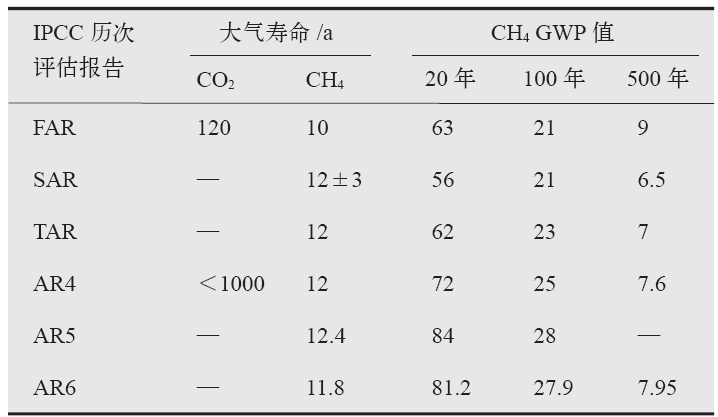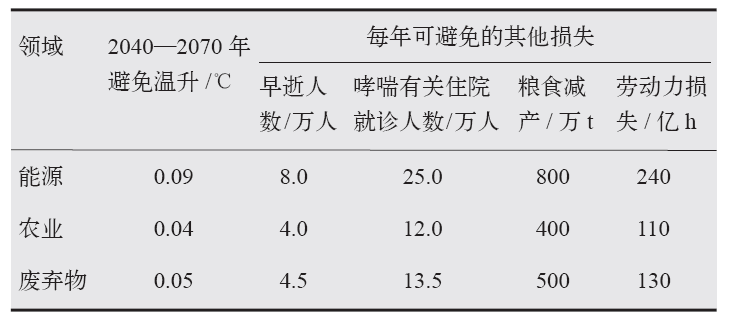Climate Change Research ›› 2023, Vol. 19 ›› Issue (6): 683-692.doi: 10.12006/j.issn.1673-1719.2023.121
• The characters, control and cost-benefits of methane emissions • Previous Articles Next Articles
Overview on global policies and measures to control methane emissions and its implications for China
- Energy Research Institute, China Academy of Macroeconomics, Beijing 100038, China
-
Received:2023-06-02Revised:2023-08-18Online:2023-11-30Published:2023-10-30
Cite this article
HUI Jing-Xuan, ZHU Song-Li. Overview on global policies and measures to control methane emissions and its implications for China[J]. Climate Change Research, 2023, 19(6): 683-692.
share this article
Add to citation manager EndNote|Ris|BibTeX
URL: http://www.climatechange.cn/EN/10.12006/j.issn.1673-1719.2023.121
 |
Table 1 Atmospheric lifetime and global warming potential (GWP) values at different time scales given in previous IPCC assessment reports of CO2 and CH4
 |
| [1] | 国务院. 中美关于在21世纪20年代强化气候行动的格拉斯哥联合宣言[EB/OL]. 2021 [2023-05-25]. https://www.gov.cn/xinwen/2021-11/11/content_5650318.htm. |
| The State Council of the People’s Republic of China. U.S.-China joint Glasgow declaration on enhancing climate action in the 2020s[EB/OL]. 2021 [2023-05-25]. https://www.gov.cn/xinwen/2021-11/11/content_5650318.htm (in Chinese) | |
| [2] | 马占云, 李照濛, 刘舒乐, 等. 全球甲烷控排对中国的启示[J]. 中国能源, 2023, 1-2: 20-30. |
| Ma Z Y, Li Z M, Liu S L, et al. Global experiences in mitigating methane emissions and its implication for China[J]. Energy of China, 2023, 1-2: 20-30 (in Chinese) | |
| [3] | 龙凤, 董战峰, 连超, 等. 甲烷排放控制的国际经验及对我国的启示[J]. 环境保护, 2023, 51 (1): 68-71. |
| Long F, Dong Z F, Lian C, et al. International experience of methane emission control and its inspiration to China[J]. Environmental Protection, 2023, 51 (1): 68-71 (in Chinese) | |
| [4] | 美国环保协会. 国内外甲烷排放控制行动与趋势[EB/OL]. 2021 [2023-08-15]. http://www.cet.net.cn/uploads/soft/202103/1_29104647.pdf. |
| Environmental Defense Fund. Domestic and foreign methane emission control actions and trends[EB/OL]. 2021 [2023-08-15]. http://www.cet.net.cn/uploads/soft/202103/1_29104647.pdf (in Chinese) | |
| [5] | 张建宇, 秦虎, 汪维. 中国开展甲烷排放控制关键问题与建议[J]. 环境与可持续发展, 2019, 44 (5): 4. |
| Zhang J Y, Qin H, Wang W. Key issues and suggestions on methane emission control in China[J]. Environment and Sustainable Development, 2019, 44 (5): 4 (in Chinese) | |
| [6] | IPCC. Synthesis report of the Sixth Assessment Report: a report of the Intergovernmental Panel on Climate Change[EB/OL]. 2023 [2023-05-25]. https://www.ipcc.ch/ar6-syr/ |
| [7] | World Meteorological Organization WMO. Greenhouse gas bulleti No.18: the state of greenhouse gases in the atmosphere based on global observations through 2021 [EB/OL]. 2022 [2023-05-25]. https://library.wmo.int/index.php?lvl=notice_display&id=22149#.ZHbduSOS2hc |
| [8] | IPCC. Climate change 2021: the physical science basis[EB/OL]. 2021 [2023-05-25]. https://www.ipcc.ch/report/sixth-assessment-report-working-group-i/ |
| [9] | 马翠梅. 碳核算理论与实践[M]. 北京: 中国环境出版集团, 2022: 9-11. |
| Ma C M. Carbon accounting theory and practice[M]. Beijing: China Environmental Publishing Group, 2022: 9-11 (in Chinese) | |
| [10] | United Nations Framework Convention on Climate Change UNFCCC. Decision 18/CMA.1 modalities, procedures and guidelines for the transparency framework for action and support referred to in Article 13 of the Paris Agreement[EB/OL]. 2018 [2023-05-25]. https://unfccc.int/documents/184700 |
| [11] |
Saunois M, Stavert A R, Poulter B, et al. The global methane budget 2000-2017[J]. Earth System Science Data, 2020, 12 (3): 1561-1623
doi: 10.5194/essd-12-1561-2020 URL |
| [12] |
Chang J, Peng S, Ciais P, et al. Revisiting enteric methane emissions from domestic ruminants and their δ13C CH4 source signature[J]. Nature Communications, 2019, 10: 1-14
doi: 10.1038/s41467-018-07882-8 |
| [13] | Schiermeier Q. Global methane levels soar to record high[EB/OL]. 2020 [2023-05-30]. https://www.nature.com/articles/d41586-020-02116-8 |
| [14] | International Energy Agency IEA. Global methane tracker 2023 [EB/OL]. 2023 [2023-05-25]. https://www.iea.org/reports/global-methane-tracker-2023 |
| [15] | United Nations Framework Convention on Climate Change UNFCCC. Greenhouse gas inventory data: detailed data by party[EB/OL]. 2023 [2023-05-25]. https://di.unfccc.int/detailed_data_by_party |
| [16] | 朱松丽. 发展中国家农村民用炉灶的温室气体和污染物排放因子研究[J]. 可再生能源, 2004 (2): 16-19. |
| Zhu S L. Study on emission factors of GHG and pollutants from rural stoves in developing countries[J]. Renewable Energy Resources, 2004 (2): 16-19 (in Chinese) | |
| [17] | 国家发展和改革委员会应对气候变化司. 2005中国温室气体清单研究[M]. 北京: 中国环境出版社, 2014: 66. |
| Department of Climate Change, National Development and Reform Commission of the People’s Republic of China.2005 The People’s Republic of China national greenhouse gas inventory[M]. Beijing: China Environmental Publishing Group, 2014: 66 (in Chinese) | |
| [18] | 丛宏斌, 赵立欣, 王久臣, 等. 中国农村能源生产消费现状与发展需求分析[J]. 农业工程学报, 2017, 33 (17): 224-231. |
| Cong H B, Zhao L X, Wang J C, et al. Current situation and development demand analysis of rural energy in China[J]. Transactions of the Chinese Society of Agricultural Engineering, 2017, 33 (17): 224-231 (in Chinese) | |
| [19] | The White House. U.S methane emission reduction action plan[EB/OL]. 2021 [2023-05-25]. https://www.whitehouse.gov/wp-content/uploads/2021/11/US-Methane-Emissions-Reduction-Action-Plan-1.pdf |
| [20] | United States Congress. H.R. 3684: infrastructure investment and jobs act[EB/OL]. 2022 [2023-08-15]. https://www.congress.gov/bill/117th-congress/house-bill/3684 |
| [21] | Unites States Environmental Protection Agency EPA. Biden-Harris administration strengthens proposal to cut methane pollution to protect communities, combat climate change, and bolster American innovation[EB/OL]. 2022 [2023-05-30]. https://www.epa.gov/newsreleases/biden-harris-administration-strengthens-proposal-cut-methane-pollution-protect |
| [22] | United States. 2022 U.S. climate ambition report: eighth national communication and Fifth biennial report of the United States of America to the United Nations Framework Convention on Climate Change[EB/OL]. 2022 [2023-03-15]. https://unfccc.int/documents/624756 |
| [23] | The European Commission. EU strategy to reduce methane emissions[EB/OL]. 2020 [2023-05-25]. https://ec.europa.eu/energy/sites/ener/files/eu_methane_strategy.pdf |
| [24] | The European Commission. Proposal for a regulation of the European Parliament and of the council on methane emissions reduction in the energy sector and amending regulation (EU) 2019/942 [EB/OL]. 2021 [2023-08-15]. https://eur-lex.europa.eu/legal-content/EN/TXT/?uri=COM%3A2021%3A805%3AFIN |
| [25] | 生态环境部. 煤层气(煤矿瓦斯)排放标准(暂行)[EB/OL]. 2008 [2023-05-25]. https://www.mee.gov.cn/ywgz/fgbz/bz/bzwb/dqhjbh/dqgdwrywrwpfbz/200804/t20080414_121137.shtml. |
| Ministry of Ecological Environment of People’s Republic of China. Coal-bed methane (coal mine gas) emission (Interim)[EB/OL]. 2008 [2023-05-25]. https://www.mee.gov.cn/ywgz/fgbz/bz/bzwb/dqhjbh/dqgdwrywrwpfbz/200804/t20080414_121137.shtml (in Chinese) | |
| [26] | 中国石化集团. 中国石化等7企联合发起成立中国油气企业甲烷控排联盟[EB/OL]. 2021 [2023-05-25]. http://www.chinacpc.com.cn/info/2021-05-18/news_5283.html. |
| Sinopec. 7 enterprise including Sinopec jointly sponsored by China’s oil and gas companies such as methane control league[EB/OL]. 2021 [2023-05-25]. http://www.chinacpc.com.cn/info/2021-05-18/news_5283.html (in Chinese) | |
| [27] | 国务院. 国务院办公厅关于转发国家发展改革委住房城乡建设部生活垃圾分类制度实施方案的通知[EB/OL]. 2017 [2023-05-25]. https://www.gov.cn/zhengce/content/2017-03/30/content_5182124.htm. |
| The State Council of The People’s Republic of China. Notice of the general office of the State Council on forwarding the implementation plan of household waste classification system of the Ministry of Housing and Urban-Rural Development of the National Development and Reform Commission[EB/OL]. 2017 [2023-05-25]. https://www.gov.cn/zhengce/content/2017-03/30/content_5182124.htm (in Chinese) | |
| [28] | 国务院. 中华人民共和国国民经济和社会发展第十四个五年规划和2035年远景目标纲要[EB/OL]. 2021 [2023-05-25]. https://www.gov.cn/xinwen/2021-03/13/content_5592681.htm. |
| The State Council of the People’s Republic of China. The 14th five-year plan for national economic and social development of the People’s Republic of China and the outline of the long-range goals for 2035 [EB/OL]. 2021 [2023-05-25]. https://www.gov.cn/xinwen/2021-03/13/content_5592681.htm (in Chinese) | |
| [29] | 国务院. 中国向联合国气候变化框架公约秘书处提交国家自主贡献报告[EB/OL]. 2021 [2023-05-25]. https://www.gov.cn/xinwen/2021-10/29/content_5647512.htm. |
| The State Council of the People’s Republic of China. China submits its intended nationally determined contributions to the secretariat of the United Nations Framework Convention on Climate Change[EB/OL]. 2021 [2023-05-25]. https://www.gov.cn/xinwen/2021-10/29/content_5647512.htm (in Chinese) | |
| [30] | 谢飞, 田文寿, 李建平, 等. 未来甲烷排放增加对平流层水汽和全球臭氧的影响[J]. 气象学报, 2013, 71 (3): 13. |
| Xie F, Tian W S, li J P, et al. Effects of future increased methane emissions on stratospheric water vapor and global ozone[J]. Acta Meteorologica Sinica, 2013, 71 (3): 13 (in Chinese) | |
| [31] | Climate Clean Air Coalition CCAC. Global methane assessment[EB/OL]. 2021 [2023-05-25]. https://www.ccacoalition.org/en/resources/global-methane-assessment-full-report |
| [32] | 中华人民共和国农业农村部. 中国农业展望报告(2023—2032) [EB/OL]. 2023 [2023-05-25]. https://www.moa.gov.cn/ztzl/ymksn/spbd/qt/202304/t20230421_6425890.htm. |
| Ministry of Agriculture and Rural Affairs of the People’s Republic of China. China agricultural outlook report (2023-2032) [EB/OL]. 2023 [2023-05-25]. https://www.moa.gov.cn/ztzl/ymksn/spbd/qt/202304/t20230421_6425890.htm (in Chinese) |
| [1] | LI Yi-Xi, WANG Xiao, XU Hong-Wei, LIAO Cheng-Hao, ZHANG Yong-Bo. Analysis on CH4 emission characteristics and control policies of municipal waste disposal in Guangdong province [J]. Climate Change Research, 2023, 19(5): 582-591. |
| [2] | QIN Xiao-Bo, WANG Jin-Ming, WANG Bin, WAN Yun-Fan. Status of methane emissions from paddy fields, mitigation technologies and strategic pathways for low-carbon production [J]. Climate Change Research, 2023, 19(5): 541-558. |
| [3] | YANG Shan-Shan, GUO Hao, YANG Xiu, LI Zheng. Consideration and prospect of total carbon emission control system under the double carbon target [J]. Climate Change Research, 2023, 19(2): 191-202. |
| [4] | LIAO Hong, XIE Pei-Fu. The roles of short-lived climate forcers in a changing climate [J]. Climate Change Research, 2021, 17(6): 685-690. |
| Viewed | ||||||
|
Full text |
|
|||||
|
Abstract |
|
|||||




